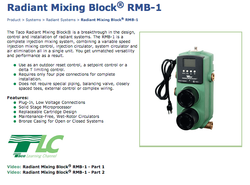Either way all the extractable heat is gone from the tank.
I think chuck's central question in this thread and one that has been discussed regularly here is how to redefine that term "extractable". All the theoretical thermodynamics can help point to understanding what's going on and man can it kill a whole lot of beer hanging around with grad students but I think we're talking hardware here.
Fin tube baseboard has a very small surface area compared to other emitters used in residential HVAC. To get the heat exchange rate needed for the current weather conditions ('rate' is the important element here) you need to stuff higher temperature water through it than an emitter with a larger surface area (radiant floor or ceiling would be extreme counterexample). Heat exchange is directly related to temperature difference AND surface area. More of one needs less of the other to get the job done.
So, since were talking wood boilers with heat storage tanks, all those BTUs in the tank are not necessarily "extractable" if your emitters can't get the heat out of the water fast enough to keep up with the rate of heat loss of the house. You might just as well not have bothered to burn the wood it took to get them in the tank. Yes, that heat is there and it could be used and it would be 'heating' the house if you kept circulating it (until it was the same temperature as outdoors, at which point we will have achieved maximum entropy) but it would not keep up with the rate of heat loss and it would quickly be felt as something more like cooling than heating in the house.
Lot of people contributing to this forum are in the same boat as you, chuck. Your house was not designed to run off a heat storage tank. Your baseboards were designed for 180F bang-bang hot water supply on, off, on, off.... As long as the wood boiler is ripping it can go forever and keep up the the water temperature the baseboards are clamoring for. But at some point the fire will burn out and so will you and the heat storage tank takes over so you can get some sleep.
Some guys might pick up this line of design thought and work toward getting the lowest tank temp/longest run time between firings. Some guys will race whatever you hand them. And with NASA's budget you could get a WHOLE bunch of heat out of there. But I think the question that is on everyone's mind is how to get not the most but the minimum required sleep (or hours away at work) between firings with simple hardware.
Temperature mixing to match outdoor conditions probably won't help with the baseboards the way they were. I agree with Eliot.
But adding more fin tube to those you have increases their surface area and that will lower the temperature of the water that can usefully keep up with the heat loss of the house. Then you can get more hours/ tank. How far you can go with this will be up to the interior decorator in your family. But it's going to help.
And equally important, I think, is Nofossil's point that the lower the water temperature you send out to those baseboards the lower the temp of the water coming back into the tank. This is where temp mixing might help by using (and therefore returning) the lowest temp water needed. Anything you can do to preserve the stratification and maximize the temp difference in the tank will help you get more "extractable" heat out of it, regardless how many total BTUs there are in there.
And now, some hours after I wrote this, I see Nofossil has given a better example, as usual, of the stratification argument. I'll submit this anyway. Don't want to waste my two cents.



